
Villager Liu Jintu (L) leads his camel in the Qikou ancient town of Linxian County, north China's Shanxi Province, Aug. 2, 2023. Seeing the rapid development of tourism in the Qikou ancient town, Liu quit his job at construction sites. He bought a camel in 2016 and provided it to tourists for rides.
Qikou, an ancient riverine town along the Yellow River, was an important trade ferry in history. However, with the development of land transportation, the Qikou ancient town declined in terms of trade volume, leaving many of its historical buildings in disrepair.
In recent years, local authorities have carried out protection and restoration of historical buildings and ancient dwellings in the Qikou ancient town. At the same time, the integrated development of culture and tourism is also promoted.
Today the ancient town has become a popular tourist attraction. More than 5,000 people out of a population of about 30,000 in the town are engaged in the tourism industry. (Xinhua/Zhan Yan)
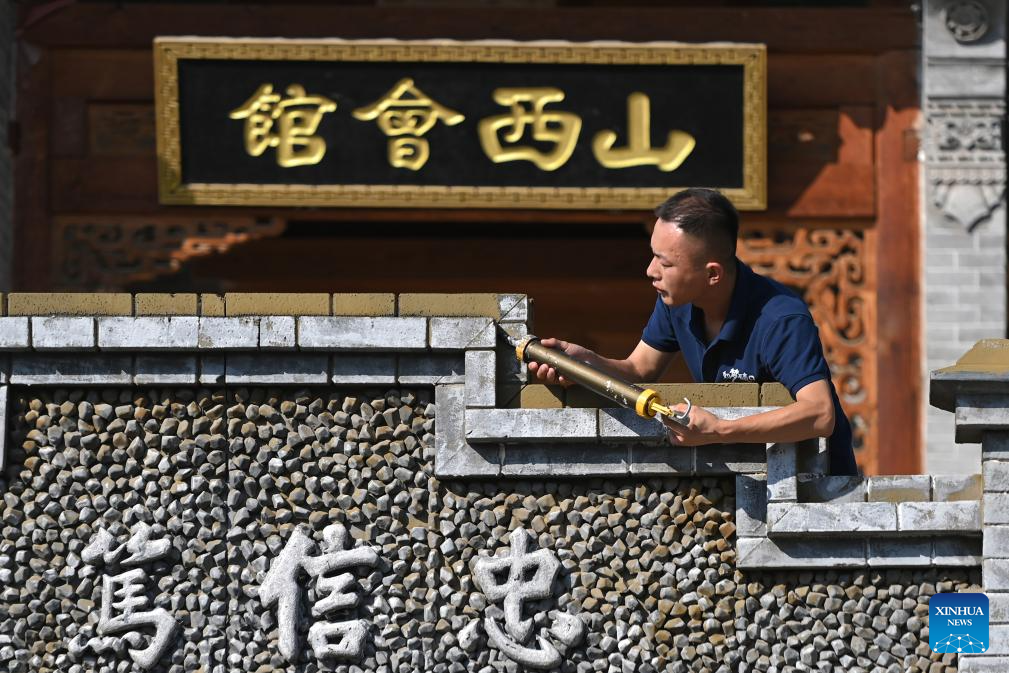
Villager Li Tan'en works at a theater in Qikou ancient town of Linxian County, north China's Shanxi Province, Aug. 2, 2023. In 2020, Li ended his career as a migrant worker and served as a staff member for a local theater in the Qikou ancient town. The job brings him an annual income of more than 50,000 yuan (about 6,848 U.S. dollars).
Qikou, an ancient riverine town along the Yellow River, was an important trade ferry in history. However, with the development of land transportation, the Qikou ancient town declined in terms of trade volume, leaving many of its historical buildings in disrepair.
In recent years, local authorities have carried out protection and restoration of historical buildings and ancient dwellings in the Qikou ancient town. At the same time, the integrated development of culture and tourism is also promoted.
Today the ancient town has become a popular tourist attraction. More than 5,000 people out of a population of about 30,000 in the town are engaged in the tourism industry. (Photo by Liu Liangliang/Xinhua)
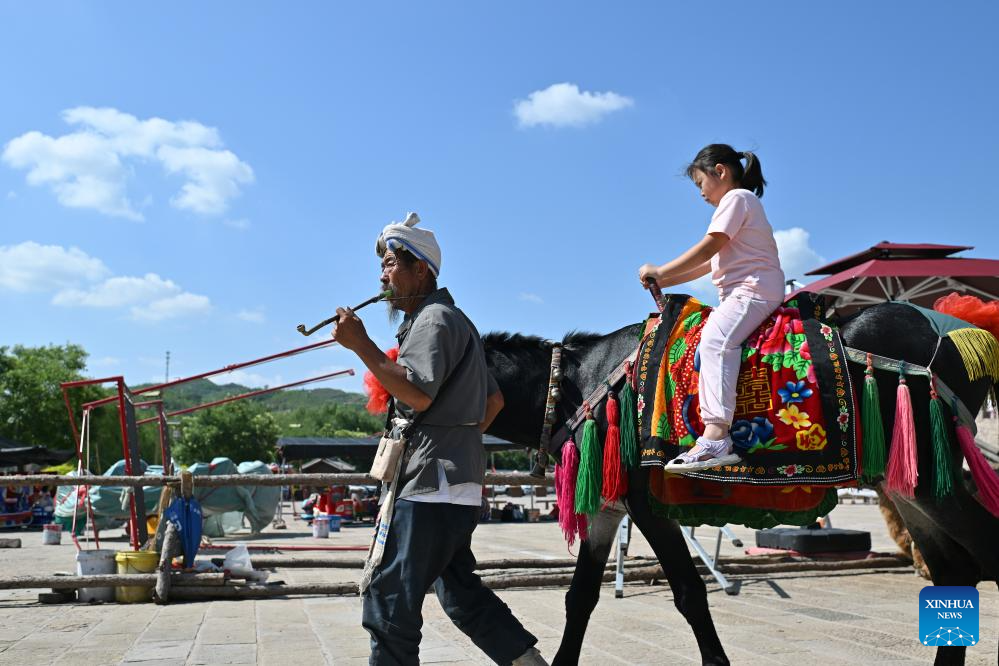
Villager Li Yonglin leads his donkey in the Qikou ancient town of Linxian County, north China's Shanxi Province, Aug. 2, 2023. Li would decorate his donkey and provide it to tourists for riding amid slack season of agricultural production.
Qikou, an ancient riverine town along the Yellow River, was an important trade ferry in history. However, with the development of land transportation, the Qikou ancient town declined in terms of trade volume, leaving many of its historical buildings in disrepair.
In recent years, local authorities have carried out protection and restoration of historical buildings and ancient dwellings in the Qikou ancient town. At the same time, the integrated development of culture and tourism is also promoted.
Today the ancient town has become a popular tourist attraction. More than 5,000 people out of a population of about 30,000 in the town are engaged in the tourism industry. (Xinhua/Zhan Yan)

Zhang Hailong invites tourists to taste his vinegar products in the Qikou ancient town of Linxian County, north China's Shanxi Province, Sept. 26, 2023. Zhang once worked as a truck driver and opened a vinegar shop in the Qikou ancient town in 2018.
Qikou, an ancient riverine town along the Yellow River, was an important trade ferry in history. However, with the development of land transportation, the Qikou ancient town declined in terms of trade volume, leaving many of its historical buildings in disrepair.
In recent years, local authorities have carried out protection and restoration of historical buildings and ancient dwellings in the Qikou ancient town. At the same time, the integrated development of culture and tourism is also promoted.
Today the ancient town has become a popular tourist attraction. More than 5,000 people out of a population of about 30,000 in the town are engaged in the tourism industry. (Photo by Liu Liangliang/Xinhua)
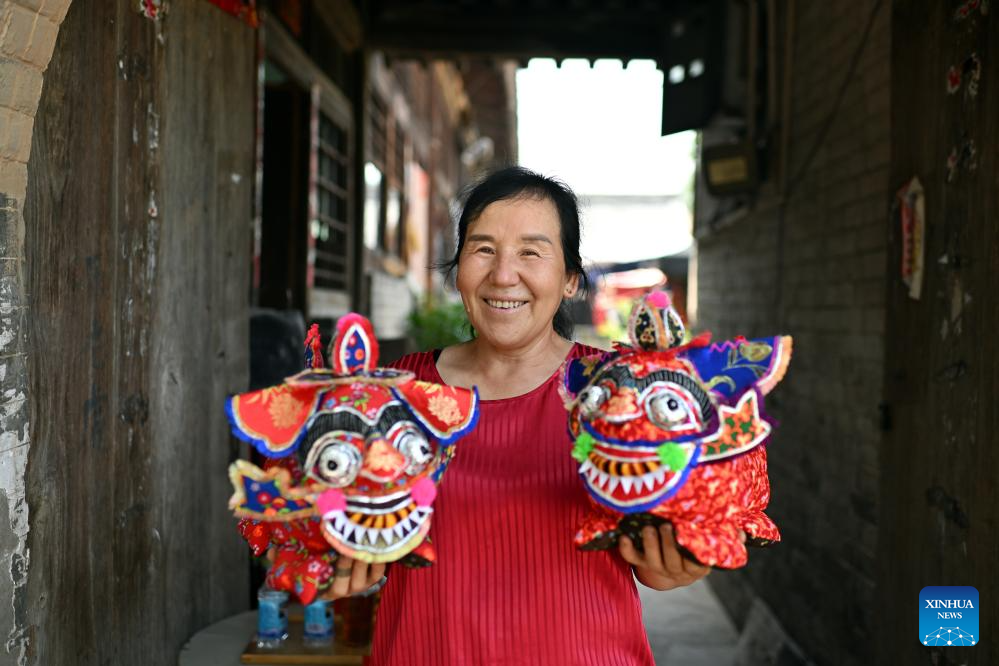
Villager Feng Yan'ai displays hand-sewn cloth tigers in the Qikou ancient town of Linxian County, north China's Shanxi Province, Aug. 2, 2023. Cloth tigers and shoes made by Feng have gained great popularity among tourists and earn her more than 30,000 yuan (about 4108 U.S. dollars) per year.
Qikou, an ancient riverine town along the Yellow River, was an important trade ferry in history. However, with the development of land transportation, the Qikou ancient town declined in terms of trade volume, leaving many of its historical buildings in disrepair.
In recent years, local authorities have carried out protection and restoration of historical buildings and ancient dwellings in the Qikou ancient town. At the same time, the integrated development of culture and tourism is also promoted.
Today the ancient town has become a popular tourist attraction. More than 5,000 people out of a population of about 30,000 in the town are engaged in the tourism industry. (Xinhua/Zhan Yan)
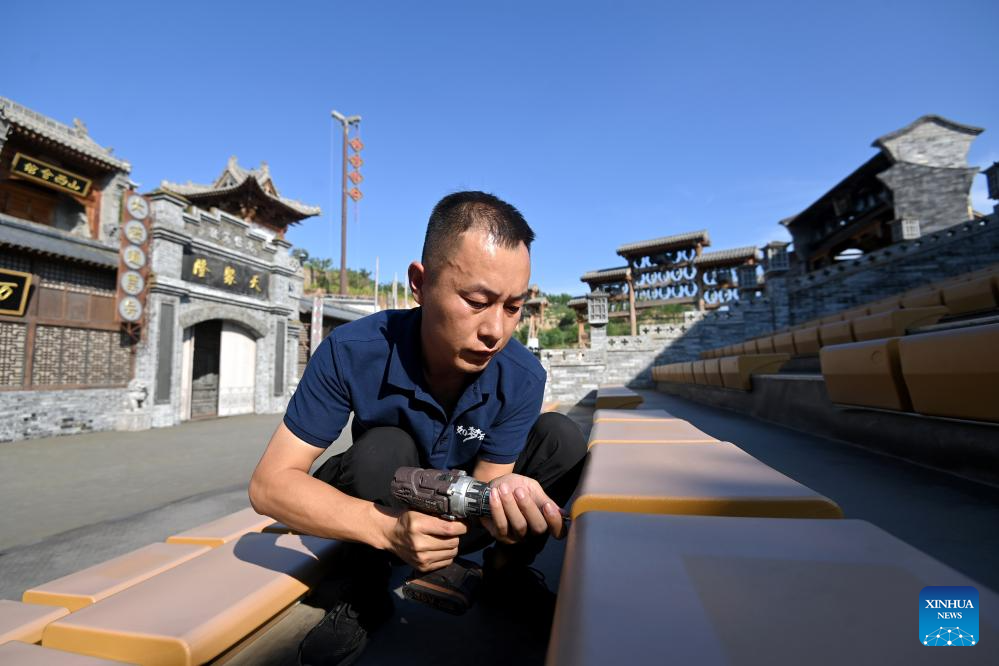
Villager Li Tan'en works at a theater in the Qikou ancient town of Linxian County, north China's Shanxi Province, Aug. 2, 2023. In 2020, Li ended his career as a migrant worker and served as a staff member for a local theater in the Qikou ancient town. The job brings him an annual income of more than 50,000 yuan (about 6,848 U.S. dollars).
Qikou, an ancient riverine town along the Yellow River, was an important trade ferry in history. However, with the development of land transportation, the Qikou ancient town declined in terms of trade volume, leaving many of its historical buildings in disrepair.
In recent years, local authorities have carried out protection and restoration of historical buildings and ancient dwellings in the Qikou ancient town. At the same time, the integrated development of culture and tourism is also promoted.
Today the ancient town has become a popular tourist attraction. More than 5,000 people out of a population of about 30,000 in the town are engaged in the tourism industry. (Photo by Liu Liangliang/Xinhua)

Villager Zhang Zhenhua (R) briefs the history of the Qikou ancient town for tourists in the Qikou ancient town of Linxian County, north China's Shanxi Province, Aug. 2, 2023. Zhang started working as a tour guide in 2006.
Qikou, an ancient riverine town along the Yellow River, was an important trade ferry in history. However, with the development of land transportation, the Qikou ancient town declined in terms of trade volume, leaving many of its historical buildings in disrepair.
In recent years, local authorities have carried out protection and restoration of historical buildings and ancient dwellings in the Qikou ancient town. At the same time, the integrated development of culture and tourism is also promoted.
Today the ancient town has become a popular tourist attraction. More than 5,000 people out of a population of about 30,000 in the town are engaged in the tourism industry. (Photo by Liu Liangliang/Xinhua)
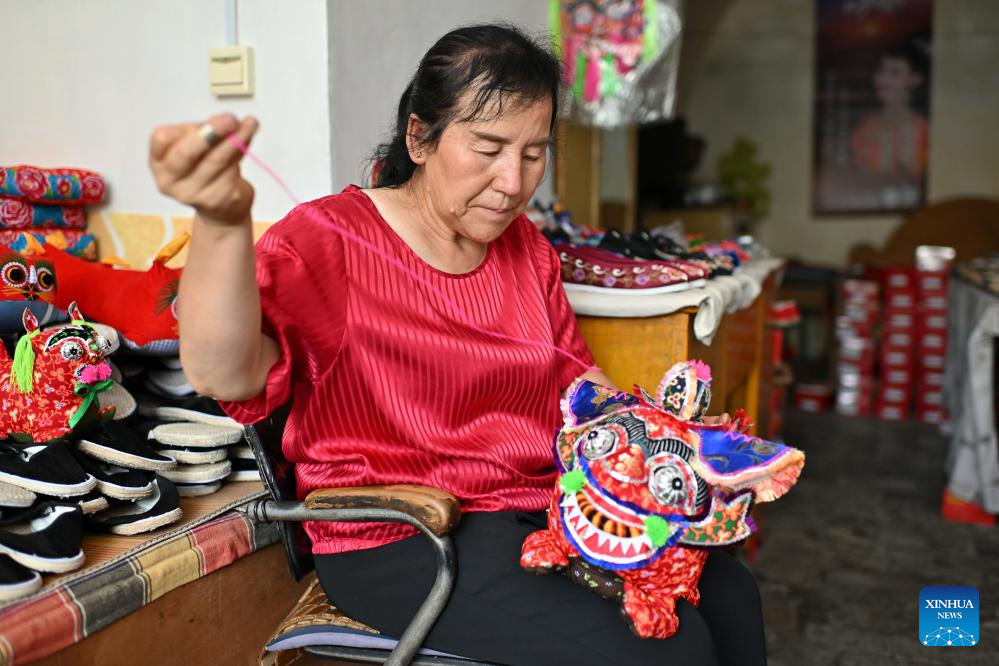
Villager Feng Yanai makes a cloth tiger in the Qikou ancient town of Linxian County, north China's Shanxi Province, Aug. 2, 2023. Cloth tigers and shoes made by Feng have gained great popularity among tourists and earn her more than 30,000 yuan (about 4108.78 U.S. dollars) per year.
Qikou, an ancient riverine town along the Yellow River, was an important trade ferry in history. However, with the development of land transportation, the Qikou ancient town declined in terms of trade volume, leaving many of its historical buildings in disrepair.
In recent years, local authorities have carried out protection and restoration of historical buildings and ancient dwellings in the Qikou ancient town. At the same time, the integrated development of culture and tourism is also promoted.
Today the ancient town has become a popular tourist attraction. More than 5,000 people out of a population of about 30,000 in the town are engaged in the tourism industry. (Xinhua/Zhan Yan)
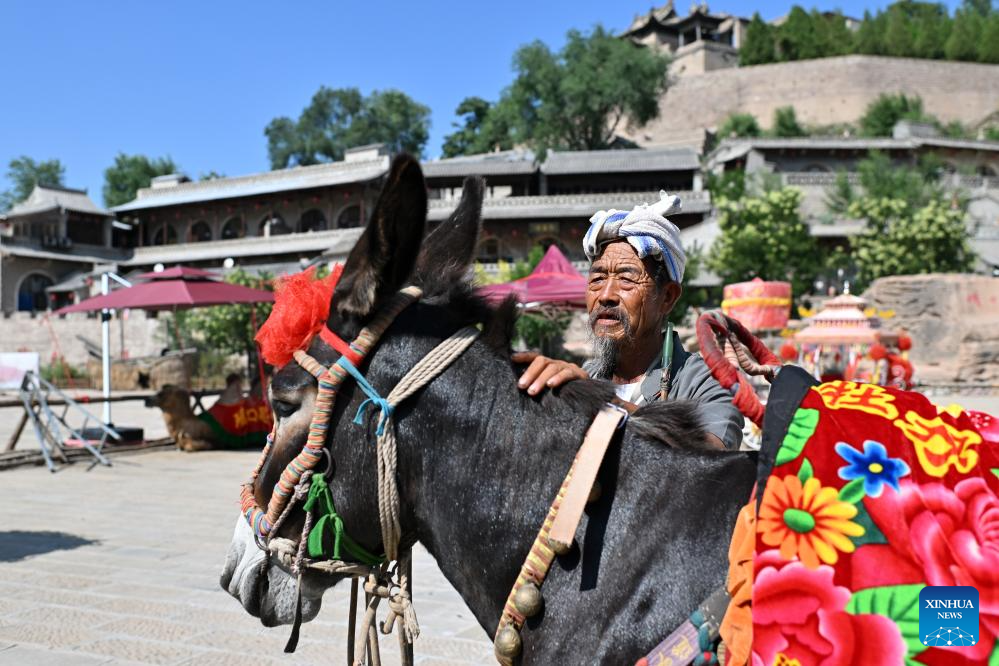
Villager Li Yonglin brushes his donkey in the Qikou ancient town of Linxian County, north China's Shanxi Province, Aug. 2, 2023. Li would decorate his donkey and provide it to tourists for riding amid slack season of agricultural production.
Qikou, an ancient riverine town along the Yellow River, was an important trade ferry in history. However, with the development of land transportation, the Qikou ancient town declined in terms of trade volume, leaving many of its historical buildings in disrepair.
In recent years, local authorities have carried out protection and restoration of historical buildings and ancient dwellings in the Qikou ancient town. At the same time, the integrated development of culture and tourism is also promoted.
Today the ancient town has become a popular tourist attraction. More than 5,000 people out of a population of about 30,000 in the town are engaged in the tourism industry. (Xinhua/Zhan Yan)
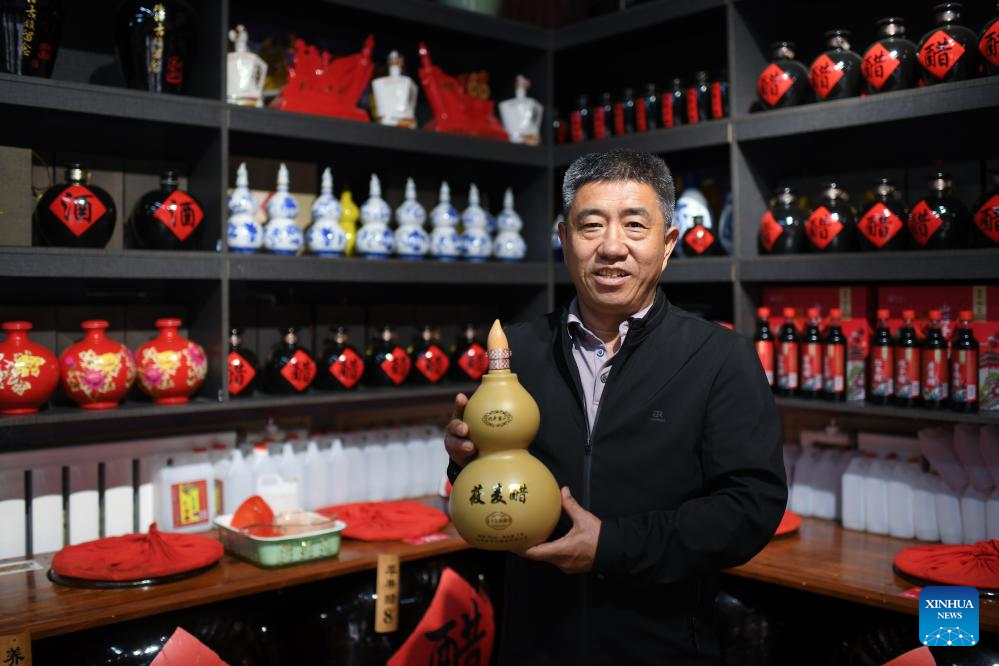
Zhang Hailong presents a vinegar product in the Qikou ancient town of Linxian County, north China's Shanxi Province, Sept. 26, 2023. Zhang once worked as a truck driver and opened a vinegar shop in the Qikou ancient town in 2018.
Qikou, an ancient riverine town along the Yellow River, was an important trade ferry in history. However, with the development of land transportation, the Qikou ancient town declined in terms of trade volume, leaving many of its historical buildings in disrepair.
In recent years, local authorities have carried out protection and restoration of historical buildings and ancient dwellings in the Qikou ancient town. At the same time, the integrated development of culture and tourism is also promoted.
Today the ancient town has become a popular tourist attraction. More than 5,000 people out of a population of about 30,000 in the town are engaged in the tourism industry. (Photo by Liu Liangliang/Xinhua)
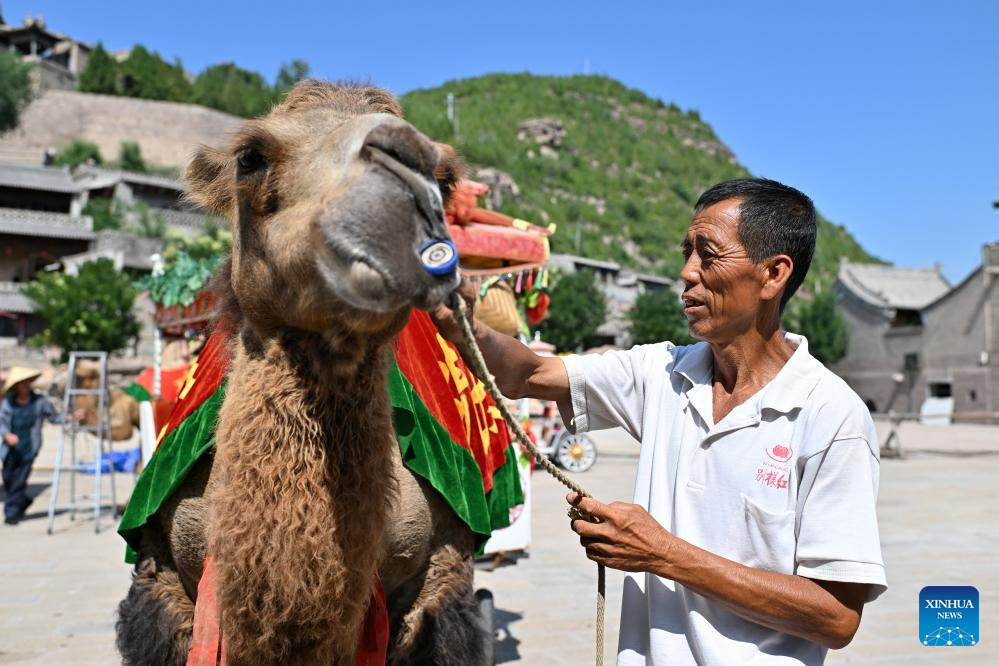
Villager Liu Jintu grooms his camel in the Qikou ancient town of Linxian County, north China's Shanxi Province, Aug. 2, 2023. Seeing the rapid development of tourism in the Qikou ancient town, Liu quit his job at construction sites. He bought a camel in 2016 and provided it to tourists for rides.
Qikou, an ancient riverine town along the Yellow River, was an important trade ferry in history. However, with the development of land transportation, the Qikou ancient town declined in terms of trade volume, leaving many of its historical buildings in disrepair.
In recent years, local authorities have carried out protection and restoration of historical buildings and ancient dwellings in the Qikou ancient town. At the same time, the integrated development of culture and tourism is also promoted.
Today the ancient town has become a popular tourist attraction. More than 5,000 people out of a population of about 30,000 in the town are engaged in the tourism industry. (Xinhua/Zhan Yan)
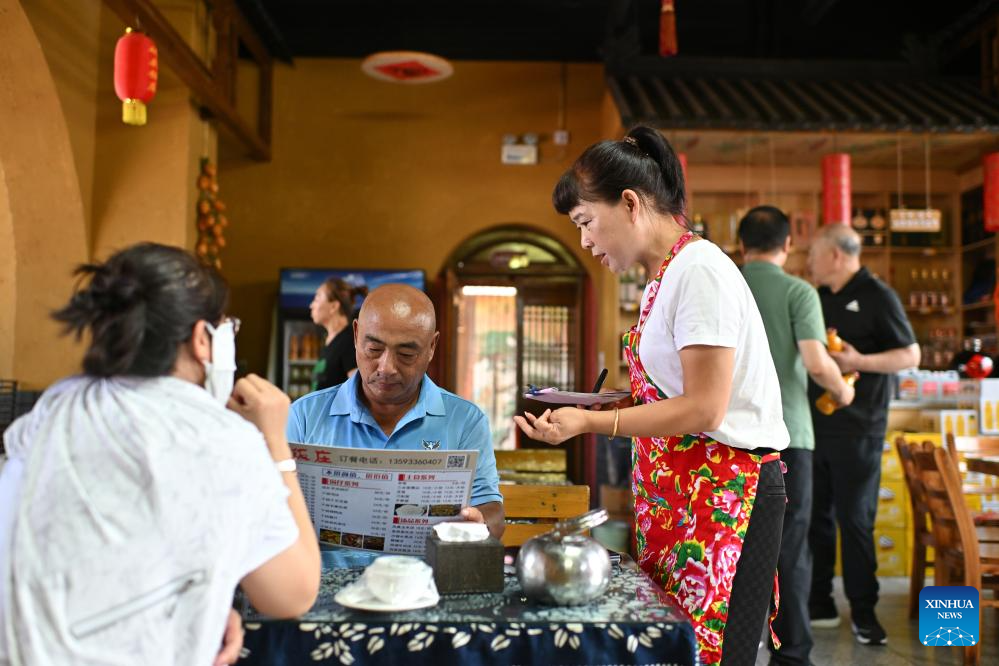
Villager Jia Juan introduces dishes of her own restaurant to tourists in the Qikou ancient town of Linxian County, north China's Shanxi Province, Aug. 2, 2023. Jia once worked as a tour guide in the Qikou ancient town and started to run a restaurant in 2011.
Qikou, an ancient riverine town along the Yellow River, was an important trade ferry in history. However, with the development of land transportation, the Qikou ancient town declined in terms of trade volume, leaving many of its historical buildings in disrepair.
In recent years, local authorities have carried out protection and restoration of historical buildings and ancient dwellings in the Qikou ancient town. At the same time, the integrated development of culture and tourism is also promoted.
Today the ancient town has become a popular tourist attraction. More than 5,000 people out of a population of about 30,000 in the town are engaged in the tourism industry. (Xinhua/Zhan Yan)
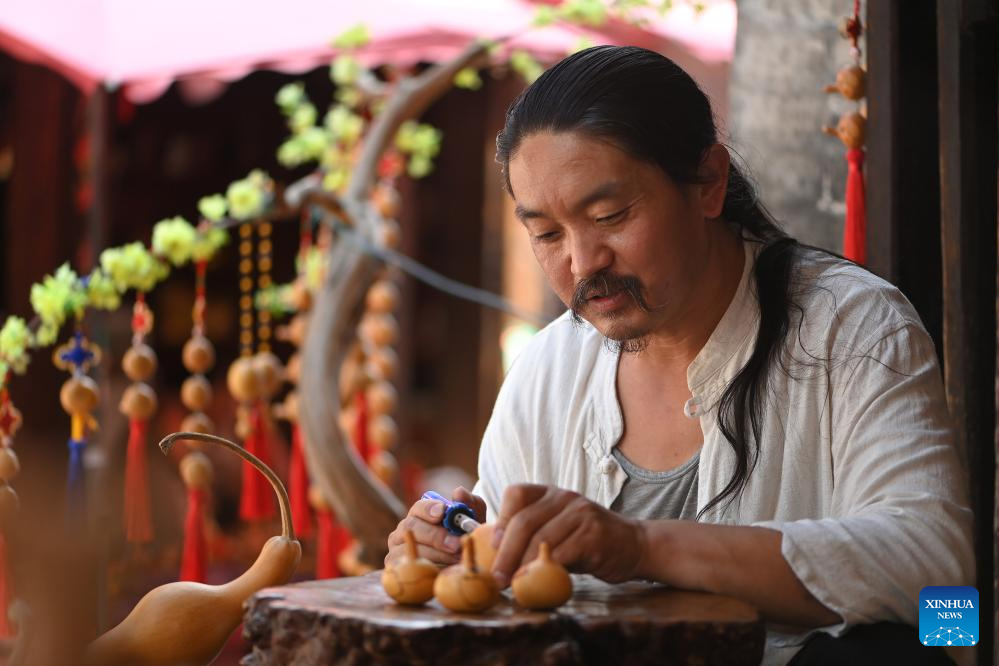
Yan Qiangqiang makes gourd crafts in the Qikou ancient town of Linxian County, north China's Shanxi Province, Aug. 2, 2023. In 2016, Yan Qiangqiang opened a store in Qikou selling gourd crafts. His craft skills brings him an annual income of more than 100,000 yuan (about 13,696 U.S. dollars).
Qikou, an ancient riverine town along the Yellow River, was an important trade ferry in history. However, with the development of land transportation, the Qikou ancient town declined in terms of trade volume, leaving many of its historical buildings in disrepair.
In recent years, local authorities have carried out protection and restoration of historical buildings and ancient dwellings in the Qikou ancient town. At the same time, the integrated development of culture and tourism is also promoted.
Today the ancient town has become a popular tourist attraction. More than 5,000 people out of a population of about 30,000 in the town are engaged in the tourism industry. (Photo by Liu Liangliang/Xinhua)

Villager Zhang Baosheng (front) rides a speedboat on the Yellow River in the Qikou ancient town of Linxian County, north China's Shanxi Province, Sept. 26, 2023. Zhang once worked on ferries. In 2000 he got a driving license of speedboats and started to drive tourists on the Yellow River for sightseeing amid slack season of agricultural production.
Qikou, an ancient riverine town along the Yellow River, was an important trade ferry in history. However, with the development of land transportation, the Qikou ancient town declined in terms of trade volume, leaving many of its historical buildings in disrepair.
In recent years, local authorities have carried out protection and restoration of historical buildings and ancient dwellings in the Qikou ancient town. At the same time, the integrated development of culture and tourism is also promoted.
Today the ancient town has become a popular tourist attraction. More than 5,000 people out of a population of about 30,000 in the town are engaged in the tourism industry. (Photo by Liu Liangliang/Xinhua)
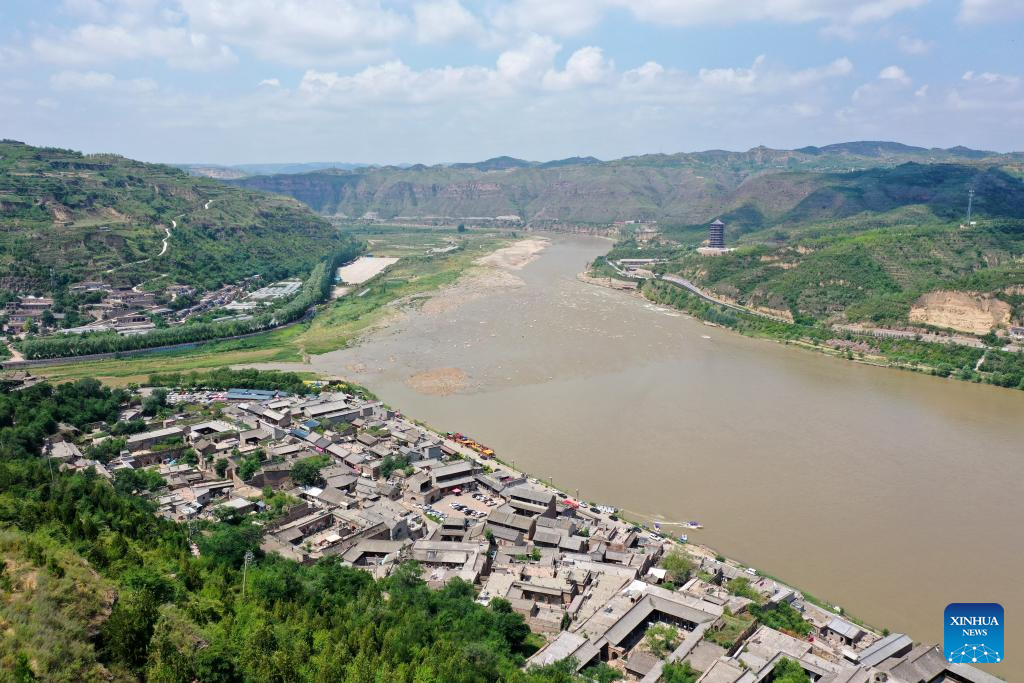
This aerial photo taken on Aug. 2, 2023 shows a view of the Qikou ancient town of Linxian County, north China's Shanxi Province.
Qikou, an ancient riverine town along the Yellow River, was an important trade ferry in history. However, with the development of land transportation, the Qikou ancient town declined in terms of trade volume, leaving many of its historical buildings in disrepair.
In recent years, local authorities have carried out protection and restoration of historical buildings and ancient dwellings in the Qikou ancient town. At the same time, the integrated development of culture and tourism is also promoted.
Today the ancient town has become a popular tourist attraction. More than 5,000 people out of a population of about 30,000 in the town are engaged in the tourism industry. (Xinhua/Zhan Yan)
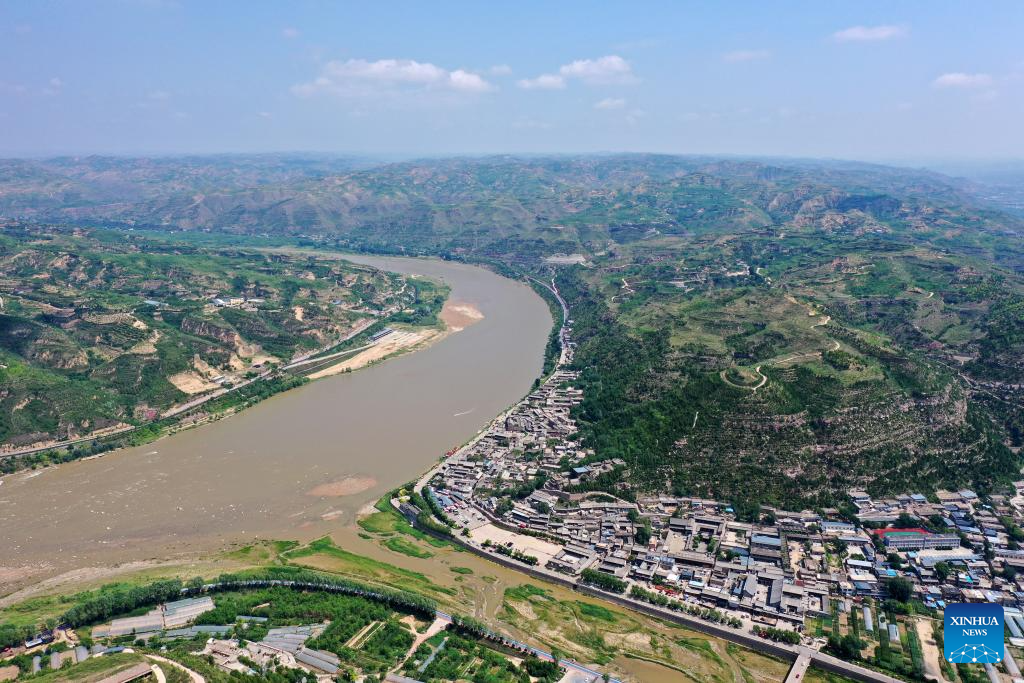
This aerial photo taken on Aug. 2, 2023 shows a view of the Qikou ancient town of Linxian County, north China's Shanxi Province.
Qikou, an ancient riverine town along the Yellow River, was an important trade ferry in history. However, with the development of land transportation, the Qikou ancient town declined in terms of trade volume, leaving many of its historical buildings in disrepair.
In recent years, local authorities have carried out protection and restoration of historical buildings and ancient dwellings in the Qikou ancient town. At the same time, the integrated development of culture and tourism is also promoted.
Today the ancient town has become a popular tourist attraction. More than 5,000 people out of a population of about 30,000 in the town are engaged in the tourism industry. (Xinhua/Zhan Yan)
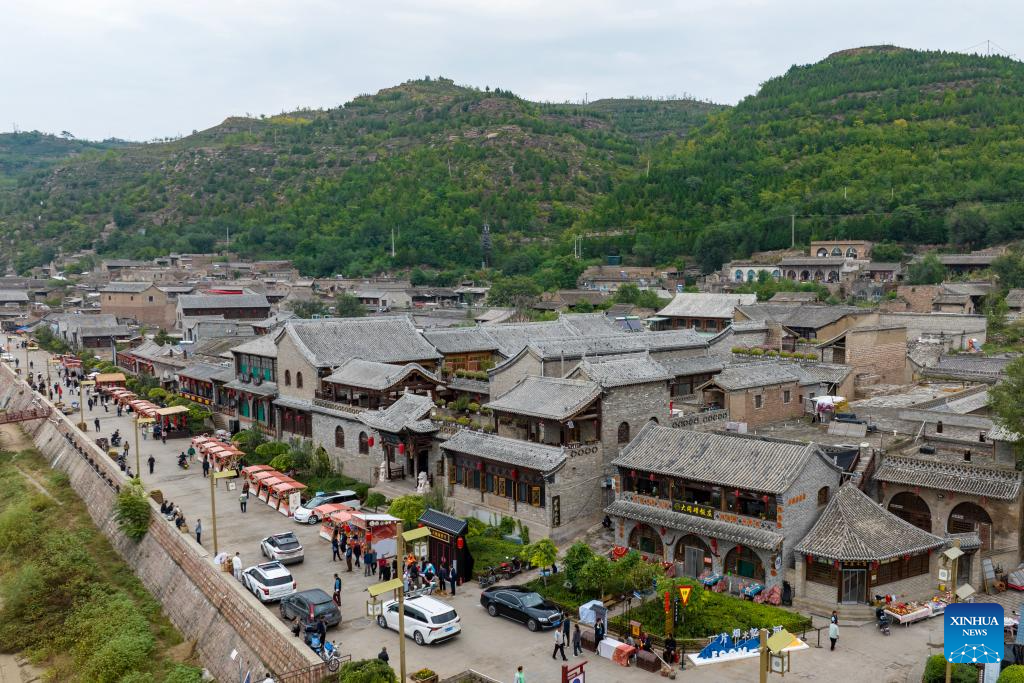
This aerial photo taken on Sept. 26, 2023 shows a view of the Qikou ancient town of Linxian County, north China's Shanxi Province.
Qikou, an ancient riverine town along the Yellow River, was an important trade ferry in history. However, with the development of land transportation, the Qikou ancient town declined in terms of trade volume, leaving many of its historical buildings in disrepair.
In recent years, local authorities have carried out protection and restoration of historical buildings and ancient dwellings in the Qikou ancient town. At the same time, the integrated development of culture and tourism is also promoted.
Today the ancient town has become a popular tourist attraction. More than 5,000 people out of a population of about 30,000 in the town are engaged in the tourism industry. (Photo by Liu Liangliang/Xinhua)
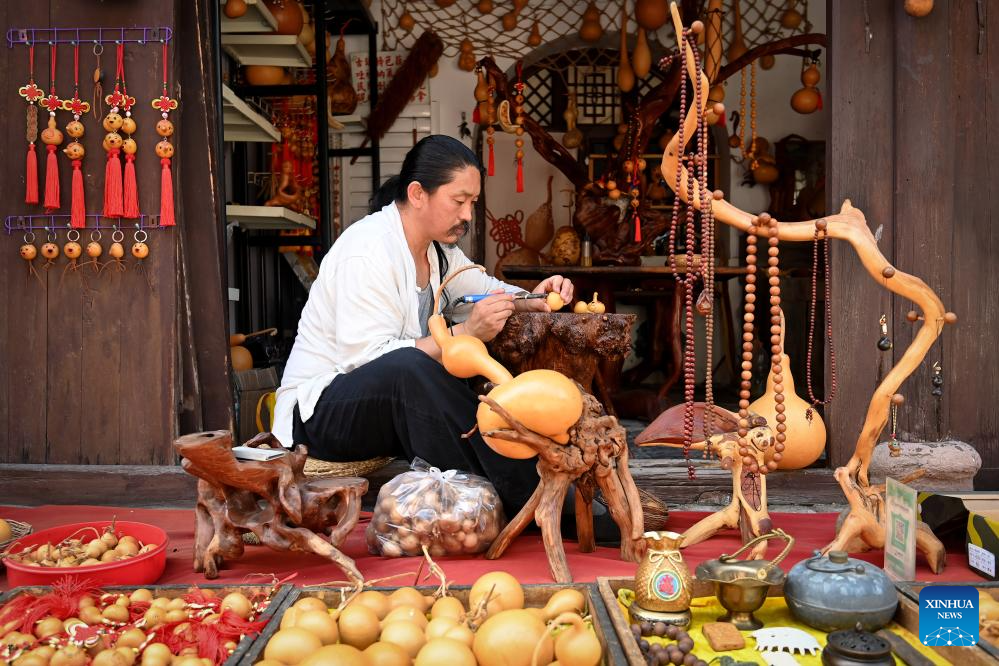
Yan Qiangqiang makes gourd crafts in the Qikou ancient town of Linxian County, north China's Shanxi Province, Aug. 2, 2023. In 2016, Yan Qiangqiang opened a store in Qikou selling gourd crafts. His craft skills brings him an annual income of more than 100,000 yuan (about 13,696 U.S. dollars).
Qikou, an ancient riverine town along the Yellow River, was an important trade ferry in history. However, with the development of land transportation, the Qikou ancient town declined in terms of trade volume, leaving many of its historical buildings in disrepair.
In recent years, local authorities have carried out protection and restoration of historical buildings and ancient dwellings in the Qikou ancient town. At the same time, the integrated development of culture and tourism is also promoted.
Today the ancient town has become a popular tourist attraction. More than 5,000 people out of a population of about 30,000 in the town are engaged in the tourism industry. (Photo by Liu Liangliang/Xinhua)
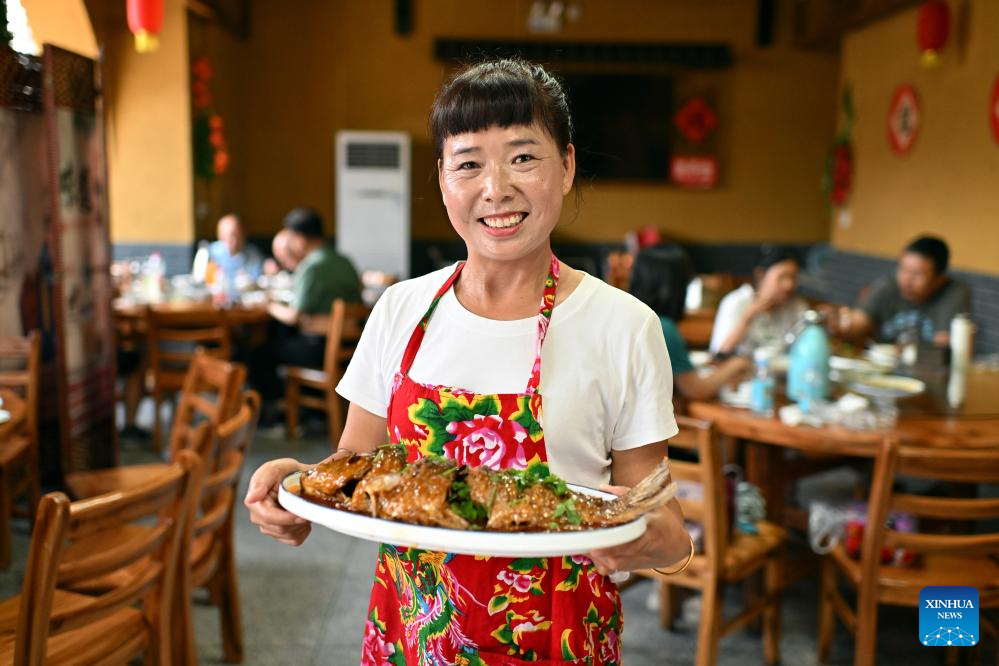
Villager Jia Juan presents a dish of her own restaurant in the Qikou ancient town of Linxian County, north China's Shanxi Province, Aug. 2, 2023. Jia once worked as a tour guide in the Qikou ancient town and started to run a restaurant in 2011.
Qikou, an ancient riverine town along the Yellow River, was an important trade ferry in history. However, with the development of land transportation, the Qikou ancient town declined in terms of trade volume, leaving many of its historical buildings in disrepair.
In recent years, local authorities have carried out protection and restoration of historical buildings and ancient dwellings in the Qikou ancient town. At the same time, the integrated development of culture and tourism is also promoted.
Today the ancient town has become a popular tourist attraction. More than 5,000 people out of a population of about 30,000 in the town are engaged in the tourism industry. (Xinhua/Zhan Yan)



